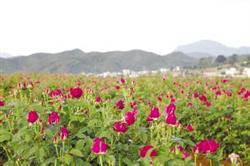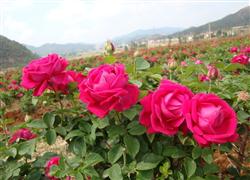High-yielding cultivation techniques of Edible Rose "Ink Red"

Edible rose has a certain ornamental value, the fragrance of flowers is overflowing, its unique fragrance and taste is excellent, it is loved by people from all walks of life in the world, and it is widely used in food industry, daily cosmetics and so on. Rose series and sugar-free rose sauce developed by the Food Research Institute of Yunnan Academy of Agricultural Sciences have aroused great interest and attention from developers. The prospect of the mall is very optimistic. Roses have been cultivated in Hongta District for many years. The edible rose was introduced from Hangzhou in 1989, adding a new spice variety to Hongta District, but the planting scale is small and can not meet the demand of the market. At present, the edible rose "ink red" has more than 30 mu, which is mainly distributed in the small field houses in Luohe, Hongta District, with a per unit yield of 200,500kg, a good planting management can reach 700kg, and the output value per mu is 1400-4900 yuan, which has better ecological, economic and social benefits. 1 the characteristic of "ink red" belongs to Rosaceae Rosaceae, deciduous or semi-evergreen shrubs, branches clustered, plant height 60-80cm, prickles hypertrophy, hook-shaped, pinnately compound leaves, leaflets usually 5-7 branches, leaves smooth, glossy, glabrous, flowers constant or solitary, pedicels long, flowers dark, reddish with black, single flower weighs 6-14g, average 7.5g, florescence from March to October, almost perennial flowers. The yield of fresh flowers is 200-300 kg per mu in the first year of planting, and 500-700 kg per mu after the third year. It has the characteristics of strong adaptability, many branches, easy flowering, long florescence, high requirement for fertilizer and not easy to cuttage propagation. Moreover, it likes light, sufficient light, exuberant plant growth, large flowers and bright color, the optimum temperature is 20-300C, the branches generally bloom from April to October, the daily average temperature is above 350C, and the dormancy period is below 50C. it is the most suitable for growth in loose, fertile and slightly acidic soil with high content of organic matter. 2 main points of cultivation techniques 2.1 Seedling propagation can be grafted with cutting annual Hangzhou rootstock or pink rose. after grafting, "ink red" has better adaptability and can be grafted before spring buds sprout. The one-year-old seedlings after grafting can be used as production seedlings after short cutting. 2.2 it is appropriate to plant in the middle and last ten days of December, dig the planting ditch before planting, apply sufficient base fertilizer, 1000 kg of farm manure per mu and 20 kg of ternary compound fertilizer. 2.3 pruning time and methods Winter pruning is generally carried out before January 10, and the backward delay will cause bleeding and affect the tree potential. Pruning in the growing season can be carried out after the whole inflorescence is in full bloom, and some of them can be thinned, and the branch distribution can be adjusted at any time to improve ventilation and light transmission. 2.4 Fertilizer and water management "ink red" has few fibrous roots, and it branches and blossoms many times a year, so it has higher requirements for fertilizer and water. The soil is required to be slightly sour, fertile and loose. Farm manure is used once in winter, and dilute farm manure can be applied every 15 days from April to September. At the same time, 20 kg of calcium and 5-8 kg of potassium sulfate are applied. Xiu water is irrigated at the beginning of spring sprouting, and then drained and irrigated depending on the weather. 2.5 the main diseases and insect pests to control "ink red" are brown spot, powdery mildew, aphids, red spiders and so on. Because most of them are edible, chemical control at flowering stage is avoided, and powdery mildew on a few pedicels can be controlled by pruning. 2.6.Flowers are usually harvested when the buds are open or when they are just opened, and the time spent every day is collected before 10:00 after the dew dries. Food flowers are usually picked on the same day, and should not be squeezed and stacked, otherwise the flowers will heat up and ferment and lose their aroma.
- Prev

How to prevent roses from rotting?
The production of pollution-free edible roses, the prevention of diseases and insect pests and the maintenance of healthy rose plants is the best way to control diseases. Usually take the following preventive measures: 1. Select disease-resistant strains and use healthy plants as seedlings. 2. Avoid applying too much nitrogen fertilizer, lest the plant will not grow strong enough.
- Next

How to prevent agaricus bisporus strain degradation
To prevent strain degeneration, can improve yield, reduce the occurrence and development of diseases and insect pests, reduce pesticide consumption, is the basis of organic Agaricus bisporus production. 1. The environmental temperature of cultured strains should not exceed 28 ℃, and the storage time of cultured strains at normal temperature should not exceed half a month. 2. The best way to get out of this is to get out of bed.
Related
- Fuxing push coffee new agricultural production and marketing class: lack of small-scale processing plants
- Jujube rice field leisure farm deep ploughing Yilan for five years to create a space for organic food and play
- Nongyu Farm-A trial of organic papaya for brave women with advanced technology
- Four points for attention in the prevention and control of diseases and insect pests of edible fungi
- How to add nutrient solution to Edible Fungi
- Is there any good way to control edible fungus mites?
- Open Inoculation Technology of Edible Fungi
- Is there any clever way to use fertilizer for edible fungus in winter?
- What agents are used to kill the pathogens of edible fungi in the mushroom shed?
- Rapid drying of Edible Fungi

